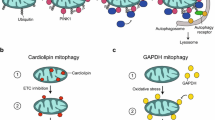Abstract
Disruptions in mitochondrial redox activity are implicated in maladies ranging from those in which cells degenerate to those in which cell division is unregulated. This is not surprising given the pivotal role of mitochondria as ATP producers, reactive oxygen species (ROS) generators, and gatekeepers of apoptosis. While increased ROS are implicated in such a wide variety of disorders, pinpointing the cause of their hyperproduction is challenging. Elevated levels of ROS can result from increases in their production and/or decreases in their turnover. Disruptions in and/or hyperactivity of NADH-ubiquinone oxidoreductase or ubiquinone-cytochrome c oxidoreductase can cause excessive ROS generation. Alternatively, if respiration is functioning in a homeostatic manner, decreases in levels or activity of antioxidants like glutathione, CuZn- and Mn-superoxide dismutase, and catalase could result in excessive ROS. Because of the diversity of disorders in which oxidative damage occurs, the most effective therapeutic strategies may be those that address the putatively diverse causes of increased ROS. Strategies for determining antioxidant activity typically involve semiquantitative measurement of relative protein levels using immunochemistry and mass spectrometry. These methods can be applied to a variety of samples, but they do not lend themselves to detection of cell-specific analyses within tissue like brain.
Because we are interested in elucidating the cause of oxidative stress in selectively vulnerable brain neurons, we have taken advantage of the easily manipulatable genetics and high fecundity of the fly. Using a cell type-targeting approach, we have driven redox sensitive green fluorescent proteins (roGFP2 ) into the mitochondria of tyrosine hydroxylase-producing (dopaminergic) neurons. In oxidizing conditions, the fluorophore’s maximal excitation wavelength reversibly shifts. Therefore, the relative amount of mitochondrial protein oxidation can be determined by taking the ratio of fluorescence excited with two different lasers. In addition, these GFPs have been independently fused to human glutaredoxin-1 (mito-roGFP2-Grx1) and yeast oxidant receptor peroxidase (mito-roGFP2-Orp1), facilitating measurements of relative mitochondrial glutathione redox potential and H2O2 levels, respectively. In order to obtain a more comprehensive observation of redox states, we capture 3D images of roGFP2 excited by two different lasers. Mito- and cytoplasmic-roGFP2 -Grx1 and -Orp1 expression can be driven by hundreds of genetic drivers in Drosophila , facilitating fixed or living whole organism or tissue- and cell-specific redox measurements.
Access this chapter
Tax calculation will be finalised at checkout
Purchases are for personal use only
Similar content being viewed by others
Change history
23 September 2022
The first name of the author Katherine L. Houlihan was unfortunately published with an error. This has now been corrected.
References
Hanson GT, Aggeler R, Oglesbee D, Cannon M, Capaldi RA, Tsien RY, Remington SJ (2004) Investigating mitochondrial redox potential with redox-sensitive green fluorescent protein indicators. J Biol Chem 279(13):13044–13053. https://doi.org/10.1074/jbc.M312846200
Gutscher M, Pauleau A-L, Marty L, Brach T, Wabnitz GH, Samstag Y, Meyer AJ, Dick TP (2008) Real-time imaging of the intracellular glutathione redox potential. Nat Methods 5(6):553
Gutscher M, Sobotta MC, Wabnitz GH, Ballikaya S, Meyer AJ, Samstag Y, Dick TP (2009) Proximity-based protein thiol oxidation by H2O2-scavenging peroxidases. J Biol Chem 284(46):31532–31540
Albrecht SC, Barata AG, Grosshans J, Teleman AA, Dick TP (2011) In vivo mapping of hydrogen peroxide and oxidized glutathione reveals chemical and regional specificity of redox homeostasis. Cell Metab 14(6):819–829. https://doi.org/10.1016/j.cmet.2011.10.010
Pandey UB, Nichols CD (2011) Human disease models in Drosophila melanogaster and the role of the fly in therapeutic drug discovery. Pharmacol Rev 63(2):411–436. https://doi.org/10.1124/pr.110.003293
Kelly SM, Elchert A, Kahl M (2017) Dissection and Immunofluorescent staining of mushroom body and photoreceptor neurons in adult Drosophila melanogaster brains. J Vis Exp (129):56174. https://doi.org/10.3791/56174
Brand AH, Perrimon N (1993) Targeted gene expression as a means of altering cell fates and generating dominant phenotypes. Development 118(2):401–415
Mao Z, Davis RL (2009) Eight different types of dopaminergic neurons innervate the Drosophila mushroom body neuropil: anatomical and physiological heterogeneity. Front Neural Circuits 3:5–5. https://doi.org/10.3389/neuro.04.005.2009
Chyb S, Gompel N (2013) Atlas of Drosophila morphology: wild-type and classical mutants. Academic Press, London
Wu JS, Luo L (2006) A protocol for dissecting Drosophila melanogaster brains for live imaging or immunostaining. Nat Protoc 1(4):2110–2115. https://doi.org/10.1038/nprot.2006.336
Acknowledgments
This work was supported with intramural funds provided by the Biomedical Sciences program at Midwestern University. We thank Giulia Bertolin at the Institute of Genetics and Development of Rennes for critical feedback on the manuscript.
Author information
Authors and Affiliations
Corresponding author
Editor information
Editors and Affiliations
Rights and permissions
Copyright information
© 2021 Springer Science+Business Media, LLC, part of Springer Nature
About this protocol
Cite this protocol
Buhlman, L.M., Keoseyan, P.P., Houlihan, K.L., Juba, A.N. (2021). Measuring Mitochondrial Hydrogen Peroxide Levels and Glutathione Redox Equilibrium in Drosophila Neuron Subtypes Using Redox-Sensitive Fluorophores and 3D Imaging. In: Weissig, V., Edeas, M. (eds) Mitochondrial Medicine . Methods in Molecular Biology, vol 2276. Springer, New York, NY. https://doi.org/10.1007/978-1-0716-1266-8_8
Download citation
DOI: https://doi.org/10.1007/978-1-0716-1266-8_8
Published:
Publisher Name: Springer, New York, NY
Print ISBN: 978-1-0716-1265-1
Online ISBN: 978-1-0716-1266-8
eBook Packages: Springer Protocols




